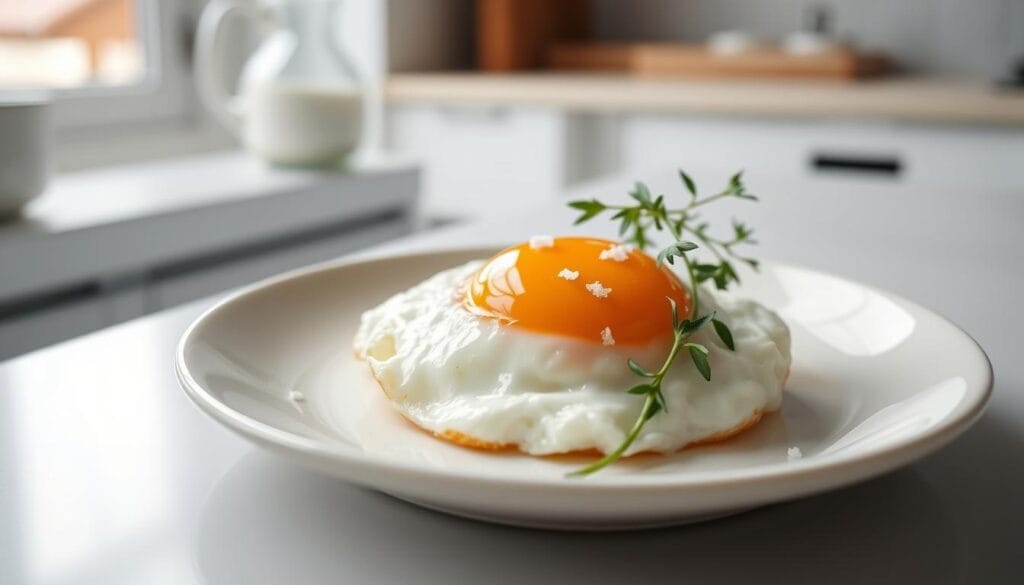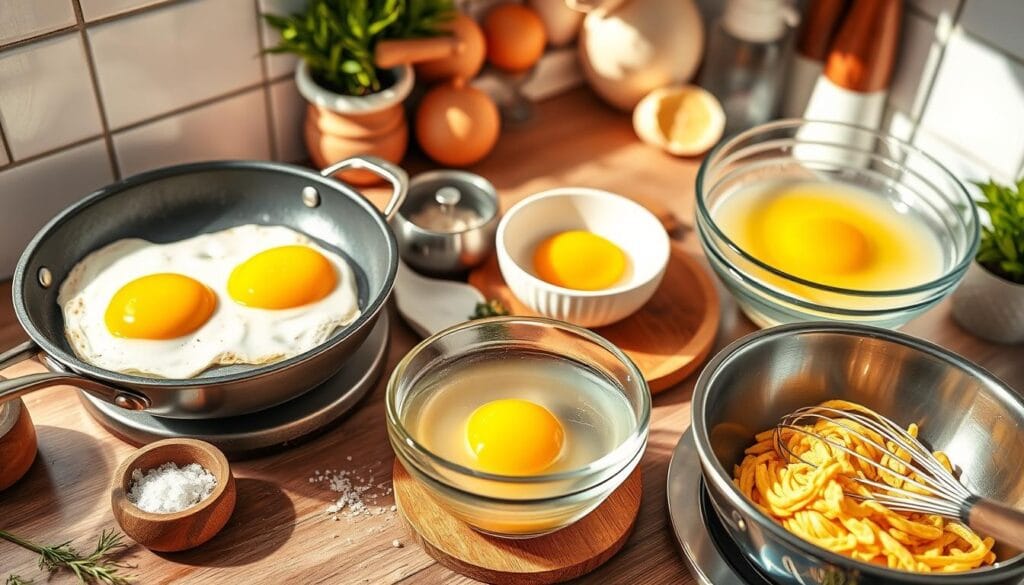There’s something special about the perfect sunny side up egg. The golden, runny yolk sits in a delicate, white cloud. As a lifelong breakfast enthusiast, I’ve mastered making these beauties. I’m excited to pass along my tips and tricks for achieving this breakfast classic
Whether you’re new to cooking or a breakfast expert, learning to make sunny side up eggs will improve your mornings and satisfy your taste buds.
Table of Contents
Understanding the Basics of Sunny Side Up Eggs
Learning to cook sunny side up eggs is a key skill in any kitchen. These eggs have firm whites and runny yolks, making them a favorite for breakfast. To get them just right, you need to know the basics.
What Makes a Perfect Sunny Side-Up Egg
The ideal sunny side up egg features perfectly crisp edges and a velvety, golden yolk. The secret is in the cooking temperature and time. The whites should be set, and the yolk soft and ready to be enjoyed.
Fresh vs. Older Eggs: What to Use
For the best sunny side up eggs, use fresh eggs. Fresh eggs hold their shape better during cooking, keeping the whites and yolks intact. Older eggs spread more in the pan, leading to a less appealing and possibly overcooked result.
Essential Equipment Needed
- Non-stick or cast iron skillet: The right pan is crucial for ensuring the eggs don’t stick and tear during the cooking process.
- Butter or oil: A small amount of fat, such as butter or olive oil, is necessary to prevent the eggs from sticking to the pan and to add flavor.
- Spatula: A sturdy, flexible spatula is essential for gently transferring the cooked eggs from the pan to the serving plate.
With the right technique and tools, you can make perfect sunny-side-up eggs. This creates a delicious breakfast or brunch that highlights the beauty and taste of fresh eggs.
Why Fresh Eggs Matter for Best Results
Fresh eggs are key for perfect sunny-side-up eggs. Their whites stay firm when cooked. Older eggs spread more, changing your dish’s look.
To test egg freshness, use the water test. Place an egg in water. If it sinks flat, it’s very fresh. If it stands up, it’s a bit older but still okay. But if it floats, it’s too old to use.
“It’s easy to tell the difference between a fresh egg and an older one when preparing sunny-side-up eggs. Fresh eggs have whites that are firmer and more well-defined.”
For beginners, using fresh, quality eggs is crucial. A fresh egg’s bright yellow yolk and firm white make your dish look and taste great.
Before you start egg preparation, check your eggs’ freshness. This small step can greatly improve your sunny side up dish.
Choosing the Right Pan and Equipment
Choosing the right pan and tools is key for cooking sunny side up eggs. Whether you pick a non-stick or cast iron skillet, the right tools can greatly improve texture and flavor.
Non-Stick vs. Cast Iron Skillets
Non-stick and cast iron skillets both have their benefits for frying eggs. Non-stick pans make it easy to flip eggs without breaking them. Cast iron skillets, on the other hand, keep heat well and cook eggs evenly, giving a nice brown bottom.
Proper Spatula Selection
The spatula you choose can affect your egg cooking success. For cast iron, a fish spatula is best because it’s thin and flexible. For non-stick pans, a nylon spatula is safer as it won’t scratch the surface.
Additional Tools Needed
- A lid to cover the pan during cooking, trapping heat and moisture for perfectly cooked eggs
- A bowl for cracking eggs, ensuring a clean and controlled transfer to the pan
By choosing the right pan and tools, you’ll get better at cooking sunny side up eggs.
| Pan Type | Recommended Spatula | Additional Tools |
|---|---|---|
| Non-stick Skillet | Nylon Spatula | Lid, Egg Cracking Bowl |
| Cast Iron Skillet | Fish Spatula | Lid, Egg Cracking Bowl |
“Using the right tools can greatly enhance your ability to cook flawless sunny-side-up eggs.”
How to Make Sunny Side Up Eggs
Learning to cook sunny side up eggs is a great skill for any cook. With a few simple steps and the right tools, you can make perfect eggs every time. This guide will show you how to make delicious sunny side up eggs that will impress anyone.
Ingredients and Equipment
To cook the perfect sunny side up eggs, you need a few basic things:
- Fresh eggs (2 eggs per serving)
- Butter or neutral cooking oil
- Salt and pepper (to taste)
- A non-stick or cast-iron skillet
- Spatula
Cooking Instructions
Here’s how to make tasty sunny side up eggs:
- Warm a non-stick or cast-iron skillet over medium-low heat, then add a bit of butter or a splash of neutral oil.
- Gently crack the eggs directly into the pan, being careful not to break the yolks. If desired, you can crack the eggs into separate bowls first and then gently slide them into the pan.
- Allow the eggs to cook for 2-3 minutes, ensuring the whites are firm while the yolks remain soft and runny. Optionally, you can cover the pan with a lid for the last minute of cooking to help the tops of the whites set.
- Sprinkle the eggs with salt and pepper according to your preference.
- Use a spatula to carefully transfer the sunny side up eggs to your plate, ensuring the yolks remain intact.
The secret to perfect sunny side up eggs is cooking them over medium-low heat. This way, the whites set while the yolks stay runny. Experiment with various cooking times and heat levels to discover your perfect method.
| Favorite Place to Eat Sunny Side Up Eggs | Ingredients Needed | Recommended Cooking Temperature |
|---|---|---|
| Waffle House | 4 | Medium heat |

“Cooking sunny side up eggs is an art form, and with a little practice, you can master the technique to perfection.”
Temperature Control and Timing Tips
Cooking sunny-side-up eggs to perfection needs careful temperature control and timing. To get that runny yolk and set whites, keep the heat moderate. This ensures the whites are set right while the yolks stay soft.
Perfect Heat Settings
For the best results, cook sunny-side-up eggs on medium-low to low heat. This slow cooking prevents overcooking and lets you control the outcome. Aim for a temperature between 275°F to 300°F. This range helps the whites set gently and the yolks stay soft.
Understanding Cooking Duration
Sunny side-up eggs usually take 2 to 3 minutes to cook perfectly. But, the exact time can change based on the pan, heat source, and egg size. Watch the eggs closely. When the whites are firm and the yolks are slightly jiggly, it’s time to take them off the heat.
“The secret to the perfect sunny side up egg is all about temperature and timing. Patience and a gentle hand are the keys to unlocking that heavenly runny yolk.”
Mastering temperature control and timing lets you make egg doneness that impresses any culinary tips lover. With these egg-cooking hacks, you’ll easily make quick egg meals that wow everyone.
Common Mistakes to Avoid When Cooking Eggs
Cooking eggs, especially sunny side up, might seem easy. But, many common mistakes can mess up your dish. Here are 10 mistakes to avoid for perfect egg dishes:
- Using too high heat – This can make eggs overcooked or burnt, losing their delicate texture and flavor.
- Breaking the yolk while cracking the egg – You need intact yolks for that sunny-side-up look.
- Flipping the egg too early – Flipping too soon can break the yolk, ruining your dish.
- Using old eggs – Fresh, quality eggs are crucial for the best taste and texture.
- Selecting the wrong type of pan – Non-stick or cast iron skillets are best for even frying.
- Not using enough fat – Butter or oil is needed to prevent sticking and ensure even cooking.
- Overcrowding the pan – Cooking eggs in batches gives them enough space to cook right.
- Neglecting to preheat the pan – Preheating the pan is key for the best results.
- Seasoning too late – Adding salt and pepper early helps flavors mix better.
- Serving the eggs immediately – Letting them rest for a minute or two helps the yolks set slightly.
Avoiding these mistakes can help you cook perfect sunny-side-up eggs. Try different egg frying methods and techniques to find what you like best. This way, you can make your simple egg meals and quick egg recipes stand out.

Serving Suggestions and Pairings
Sunny side-up eggs are great for many breakfast dishes. You can enjoy them with toast, bacon, sausage, ham, hash browns, or sautéed veggies. These breakfast dishes make for a tasty and healthy breakfast option to kick off your day.
Want to get creative with your morning egg delicacies? Try them on avocado toast, in rice bowls, or salads. These breakfast proteins can be used in many ways, making your meals exciting.
Traditional Breakfast Combinations
- Toast with sunny-side-up eggs
- Bacon and sunny-side-up eggs
- Sausage or ham paired with sunny-side-up eggs
- Hash browns or home fries with sunny-side-up eggs
- Sautéed vegetables like spinach, tomatoes, or onions with sunny-side-up eggs
Modern Serving Ideas
- Avocado toast topped with sunny-side-up eggs
- Sunny side-up eggs nestled in a hearty rice bowl
- Sunny side-up eggs added to a fresh, green salad
- Sunny side-up eggs served on garlic-rubbed toast
- Sunny side-up eggs incorporated into a breakfast taco or burrito
| Dish | Serving Suggestion |
|---|---|
| Fried Shrimp and Grits | Top with sunny-side-up eggs |
| Breakfast Tacos | Include sunny-side-up eggs as a protein |
| Fried Rice | Finish with sunny-side-up eggs |
| Roasted Asparagus | Serve with sunny-side-up eggs |
| Leftover Turkey or Chicken | Pair with sunny-side-up eggs |
Alternative Cooking Methods
While sunny-side-up eggs are a favorite, there are other ways to cook them. These methods can make your breakfast just as tasty. Try these easy and flexible options to mix up your egg routine.
Baked Eggs
Baking sunny-side-up eggs is simple and easy. Preheat your oven to 350°F (177°C). Then, heat a skillet with oil in it. Crack the eggs into the skillet and bake for 4 minutes. This way, the whites are set, and the yolks are still runny.
Shirred Eggs
- Shirred eggs offer a fancy touch. Grease ramekins or small dishes and crack an egg into each.
- Bake at 350°F (177°C) for 12-15 minutes. The whites should be set, and the yolks as you like.
- Serve the eggs hot, maybe with herbs or cheese on top.
Egg Muffins
Make sunny-side-up eggs into easy-to-eat muffins. Grease muffin cups, crack an egg into each, and bake at 350°F (177°C) for 12-15 minutes. These are great for breakfast on the go or meal prep.
| Cooking Method | Time | Temperature | Ideal Doneness |
|---|---|---|---|
| Baked Eggs | 4 minutes | 350°F (177°C) | Whites set, yolks runny |
| Shirred Eggs | 12-15 minutes | 350°F (177°C) | Whites set, yolks cooked to desired doneness |
| Egg Muffins | 12-15 minutes | 350°F (177°C) | Whites set, yolks cooked to the desired doneness |
The secret to perfect sunny-side-up eggs is the right temperature and time. Try these methods to find your favorite way to make this classic dish.
Conclusion
Learning to make sunny-side-up eggs can make your breakfast better and healthier. It’s all about using fresh eggs and the right tools. You also need to control the heat and cooking time.
This way, you’ll always get eggs with set whites and runny yolks. Sunny side-up eggs are great with traditional breakfast foods or modern dishes. They’re a must-learn for any food lover.
Getting the perfect sunny-side-up egg takes focus and practice. Try different fats and pans to see what works best for you. With these tips, you’ll soon be a pro at making delicious, nutritious meals.
Next time you want a classic breakfast or something fancy, grab some fresh eggs. Show off your sunny-side-up egg skills. Enjoy making it and relish the taste – your taste buds will love it!
FAQ
What makes a perfect sunny side-up egg?
A perfect sunny side-up egg has firm whites and a runny yolk. Fresh eggs are best because they keep their shape better when cooked.
What type of eggs should I use for sunny side up?
Fresh eggs are key for sunny-side-up eggs. Their whites stay firm better when cooked. Older eggs spread more in the pan, changing the dish’s look.
What essential equipment do I need to make sunny-side-up eggs?
You’ll need a non-stick or cast iron skillet, butter or oil, and a spatula. You might also use a lid for the pan and a bowl for cracking eggs.
How do I check the freshness of my eggs?
To check egg freshness, put the egg in a glass of water. Fresh eggs sink, while older eggs float.
What type of pan is best for cooking sunny-side-up eggs?
Non-stick or cast iron skillets are best for sunny-side-up eggs. Use a fish spatula for cast iron pans and a nylon spatula for non-stick pans.
What is the proper cooking temperature and time for sunny-side-up eggs?
Use medium-low to low heat for sunny-side-up eggs. This slow cooking prevents overcooking and gives better control. Cooking time is 2-3 minutes, depending on the pan and heat.
What are some common mistakes to avoid when making sunny-side-up eggs?
Avoid using too high heat, which can burn the eggs. Don’t break the yolk or flip the egg to keep the sunny side up look. Using old eggs or the wrong pan can also mess up the dish.
What are some good serving suggestions for sunny-side-up eggs?
Sunny side up eggs go well with toast, bacon, sausage, ham, hash browns, or sautéed veggies for breakfast. Try them on avocado toast, in rice bowls, or on salads for something new.
Is there an alternative cooking method for sunny-side-up eggs?
Yes, you can bake sunny-side-up eggs in the oven. Preheat to 350°F (177°C), heat an oven-safe skillet with oil, crack eggs, and bake for 4 minutes until the whites are set and the yolk is runny.

Comments are closed.